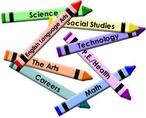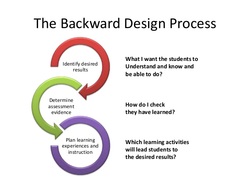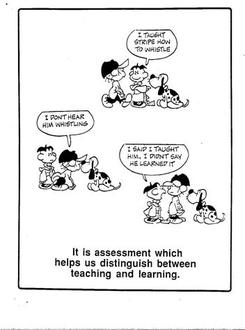Curriculum Design
Curriculum, the content knowledge and skills for every subject area, is best implemented with a clear plan of action so that the learning goal(s), identified standards, and essential questions are the focus of the assessments and instructional activities that are planned and delivered.
It is the opinion of Teaching and Learning Consulting Network, LLC that the work of Jay McTighe and Grant Wiggins in their book Understanding by Design, provides educators with an effective framework for designing and delivering curriculum. It is an appropriate and useful tool for implementing College and Career Ready Standards/Common Core Standards since the focus is on unit planning - which is a recommended course of action for integrating the requirements of the Common Core.
|
Examples & Resources
Examples of Performance Tasks:
(Baltimore Public Schools)
- High School Performance Tasks from Northern Highlands Upper Regional High School as presented at the Learning Forward Conference, December 2104.
- Elementary Science examples
(Baltimore Public Schools)
- All Things Elementary provides information, examples and links to authentic performance tasks.
- Performance Task Ideas using 6 Facets of Understanding for several content areas.
Authentic Learning and Assessment
UbD Design Guide Worksheets: Creating Authentic Assessment using Wiggins and McTighe's GRASPS process. (Goal, Role, Audience, Situation, Product (performance or purpose works too), Standards (and criteria for success). This resource will help you walk through the process, provide examples, and alternatives to the GRASPS model that still meet the criteria for developing authentic assessments.
4 Paths to Engaging Authentic Purpose and Audience. Author and consultant, John McCarthy, advocates for student voice in their learning. Identifying a real audience helps give students purpose and helps differentiate the learning experience. This is reflected in their writing or product. These 4 pathways mentioned in this article involve: Problem Solving, Advocacy, Awareness, and Publication. Identifying the pathway immediately gives purpose to the next steps required by the project.
Project Based Learning - Students actively explore real world problems, using deeper thinking, to come up with solutions based on research and evidence. This is a interdisciplinary approach to learning requiring that the student "do" rather than memorize. Edutopia provides a wealth of free educational resources including ones that support the understanding and implementation of Project Based Learning. Click HERE or on the Project Based Learning title for a direct link to Edutopia's Project Based Learning resources.
UbD Design Guide Worksheets: Creating Authentic Assessment using Wiggins and McTighe's GRASPS process. (Goal, Role, Audience, Situation, Product (performance or purpose works too), Standards (and criteria for success). This resource will help you walk through the process, provide examples, and alternatives to the GRASPS model that still meet the criteria for developing authentic assessments.
4 Paths to Engaging Authentic Purpose and Audience. Author and consultant, John McCarthy, advocates for student voice in their learning. Identifying a real audience helps give students purpose and helps differentiate the learning experience. This is reflected in their writing or product. These 4 pathways mentioned in this article involve: Problem Solving, Advocacy, Awareness, and Publication. Identifying the pathway immediately gives purpose to the next steps required by the project.
Project Based Learning - Students actively explore real world problems, using deeper thinking, to come up with solutions based on research and evidence. This is a interdisciplinary approach to learning requiring that the student "do" rather than memorize. Edutopia provides a wealth of free educational resources including ones that support the understanding and implementation of Project Based Learning. Click HERE or on the Project Based Learning title for a direct link to Edutopia's Project Based Learning resources.
- "The ongoing act of learning different subjects simultaneously. This is achieved by guiding students to identify, through research, a real-world problem...developing its solution using evidence to support the claim, and presenting the solution through a multi-media approach based in a set of 21st Century tools." Heather Wolpert-Gawron, in her 2015 blog post, "What the Heck is Project Based Learning," offers an understandable explanation of project based learning as a vehicle to support content through an active learning experience. Read more of her blog HERE.
Other Assessment Resources
- Formative Assessment Examples: West Virginia Department of Education
- 60 Formative Assessment Examples to check for understanding compiled by K. Lambert Orange County Public Schools Curriculum Services, 2012.
- Formative Assessment Blogs from Edutopia
- Rubric Types from DePaul University, Teaching Commons
- Rubric Templates (Analytic and Holistic) University of Virginia
- Designing Rubrics (How To...) from Practical Assessment, Research and Evaluation
- 53 Ways to Check for Understanding from Edutopia
K-12 Curriculum Examples and Resources:
- Anoka-Hennepin Schools, Minnesota
- Awtry Middle School, Georgia
- Boulder Valley School District, Boulder, Colorado - Music Curriculum based on UbD
- Content Area Essential Questions, International School of Bejing
- Georgia Standards: Spanish, State of Georgia Curriculum Standards
- Jay McTighe Downloads, from the author of Understanding by Design, unit/lesson templates, essential question examples and much more!
- Kentucky Model Curriculum Framework, State of Kentucky
- Curriculum & Instruction Model Curriculum, Department of Education, Massachusetts
- Math: Geometry UbD Unit Plans - Math Curriculum Wiki for all Math Subjects (Hempsfield School District)
- Physical Education, Madison, CT Schools
- Physical Education and Health/Wellness, Nanuet Public Schools, Nanuet, New York
- Rogers Public Schools, Arkansas
- Secondary Visual & Performing Arts - Curriculum examples from Pennsylvania Catholic Diocese Schools
- Science Units from Livebinders - a website devoted to instructional ideas created by teachers for teachers
- West Virginia Curriculum Information, Includes Standards, Instructional Plans, Unit and Assessment examples
- UbD Educators Wiki a free, open site that allows for membership (if you want to add or edit), or to browse for and use ideas that have been shared on this site.
*Teaching and Learning Consulting Network, LLC does not endorse or determine reliability of claims of effectiveness or alignment. Information is intended only for reader consideration.

